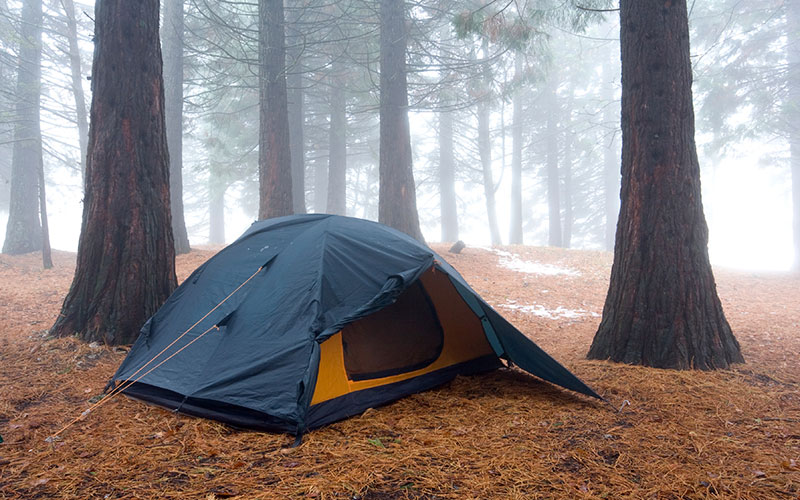

Understanding the correct way to set up guylines is of paramount importance to keeping a tent dry and sturdy.
It’s raining, it’s pouring, a big wind is roaring. In such conditions, you better have your tent guylines set up properly. If not, you can probably expect water inside your tent or—in a more serious situation—a snapped pole and tent collapse. Better to make your backcountry shelter as bomb-proof as possible. Here’s what you need to know.
Guylines serve two primary purposes
Guylines attach to loops on a tent’s rainfly and are then tautly staked into the ground a short distance from the tent. First and foremost, they keep the rainfly away from the tent body to minimize the potential for leakage. Secondly, they increase the tent’s structural stability so that heavy winds and winter snow loads don’t cause the poles to flex excessively and potentially snap. Any worthwhile tent will feature guyline loops around the base of the rainfly and midway up the fly along the pole seams to accomplish these key goals.
Keeping your tent dry
Significant condensation can collect on the underside of a rainfly, especially in cool and wet weather. If the rainfly sags against the (non-waterproof) tent body, that condensation typically works its way inside. The bottom corners and edges of the tent body are another common source of leakage, especially if water pours off the rainfly directly onto them.
To prevent this, attach guylines to the loops around the bottom of rainfly and use them to tension the fly away from the tent body, edges, and corners. Be aware that tent fabrics, especially silnylon, sag as they cool and get wet—periodically check and re-tension guylines to keep the rainfly taut.
Strengthening your tent
In heavy winds, use guylines to increase the tent’s structural stability. For this, you’ll want to utilize the guyline loops midway up the rainfly. These add the greatest strength to the tent, much more than those around the bottom.
The crucial thing to understand is this: When it comes to increasing stability, guylines are most effective when they reinforce the poles, not just the rainfly. Most quality tents have Velcro loops on the underside of the fly, directly beneath the guyline loops, which secure to the poles. These provide the crucial connection between the guylines and the tent’s pole structure. For maximum strength, set up each guyline so that it’s as close to a right angle with the pole as possible; securing it far away from the tent helps accomplish this. (By the same token, drive stakes into the ground at a right angle to the guylines to prevent them from pulling out in heavy wind.)
Tensioning your guylines
As conditions change, you’ll need to tension and periodically adjust your guylines. This can be accomplished in a variety of ways. The minimalist technique is to use a trucker’s hitch, which requires no additional hardware or accessories. It’s a simple method to learn, but can be mildly annoying to adjust and re-tension. A variety of simple accessories can make tensioning easier, though they may add an ounce or 2 of weight. A surprising multitude of guyline tensioners are available; try out a few to determine your preference.
Other considerations
Guylines can be a significant and all-but-invisible hazard underfoot. It’s easy to trip over them, which can send you tumbling or rip the loop out of the rainfly. To increase their visibility, consider placing a noticeable object or obstacle in front of them (such as your pack) or hanging something over them (shirt, socks, etc.). Some guylines have reflective material woven in, a minor asset at night.
It’s convenient to have all the guylines you’ll need attached to the rainfly before heading out, though it can add an ounce or two of extra weight and cause a tangled and annoying mess if they’re not neatly tied when not in use. Also be aware that most tents do not come with enough stakes to secure both the tent and guylines; you may need to purchase a few extra or be prepared to utilize rocks, branches, or other natural features instead.
Finally, keep in mind that the best protection against heavy winds is good overnight site selection and tent orientation. Pitch the tent lengthwise, not broadside, to the wind, and look for trees or other sheltering features of the landscape to minimize your exposure in the first place.